When it comes to steak, there is no question that Tomahawk and Ribeye cuts of beef are two of the most popular. Both are juicy, flavorful and offer an excellent experience for steak lovers. But what makes them different? In this article, we will compare and contrast Tomahawk vs Ribeye steaks so you can decide which one is right for your next meal.
What is Tomahawk Steak?
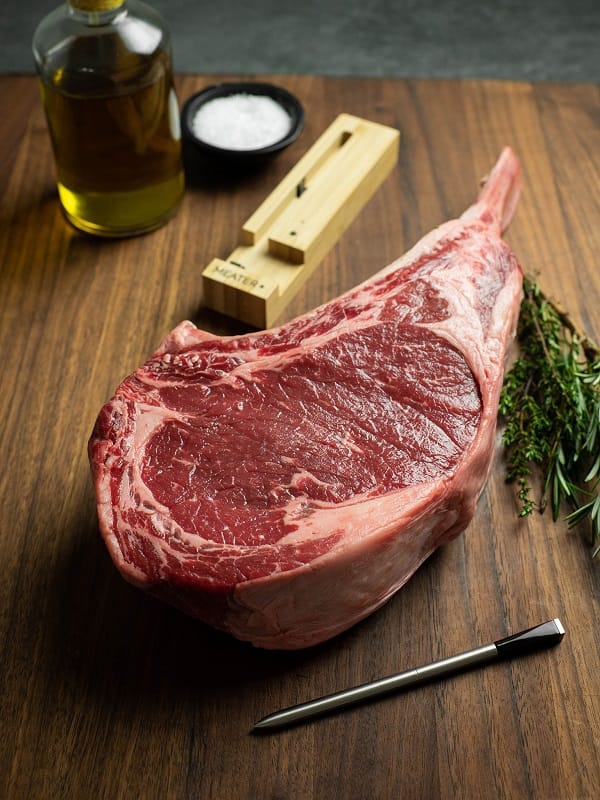
Tomahawk steak is a cut of beef that’s essentially a rib eye with the bone still attached. But here’s the kicker – the bone is extra long, making it look like a tomahawk (hence the name). And not only does it look impressive, but it also adds a unique flavor to the meat when cooked.
So how do you cook a Tomahawk steak? The most popular method is to grill it. Because of its thickness, cooking it on a lower heat for longer is important to ensure the inside is cooked without burning the outside. And, of course, don’t forget to let it rest for a few minutes after cooking to allow the juices to redistribute.
But why is Tomahawk steak so popular? Aside from its impressive appearance, it’s also incredibly flavorful and tender. The bone adds a depth of flavor that you can’t get from a boneless cut. And because it’s a ribeye, it has that perfect marbling of fat that melts into the meat as it cooks, making it juicy and delicious.
But with great flavor comes a higher price tag. Tomahawk steak is definitely on the pricier side of cuts, but it’s worth it for a special occasion or when craving a delicious steak.
What is Ribeye?
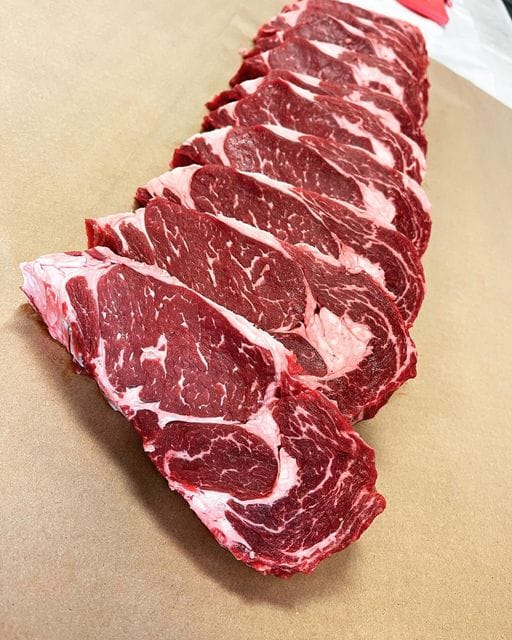
Ribeye is a ribeye that comes from the rib section of the cow. It is a heavily marbled cut, meaning it has a lot of fat running through it, which gives it its signature flavor and tenderness.
When cooking a ribeye, there are a few things to keep in mind. First and foremost, don’t be afraid of the fat. This makes the ribeye so delicious, so don’t try to trim it off or cook it out. Instead, embrace it and let it do its thing.
Another important factor is the temperature. You want to cook your ribeye at a high temperature to get a nice sear on the outside, but you also want to ensure it doesn’t overcook and dry out. I like to cook my ribeye on a screaming hot cast iron skillet for a few minutes on each side, then finish it in the oven to get it to the perfect medium-rare temperature.
But enough about cooking, let’s talk about how a ribeye tastes. To put it simply: amazing. The marbling gives it a vibrant and beefy flavor that is hard to beat. It has a nice chewy texture that is still tender enough to melt in your mouth.
Tomahawk And Ribeye: What’re The Similarities?
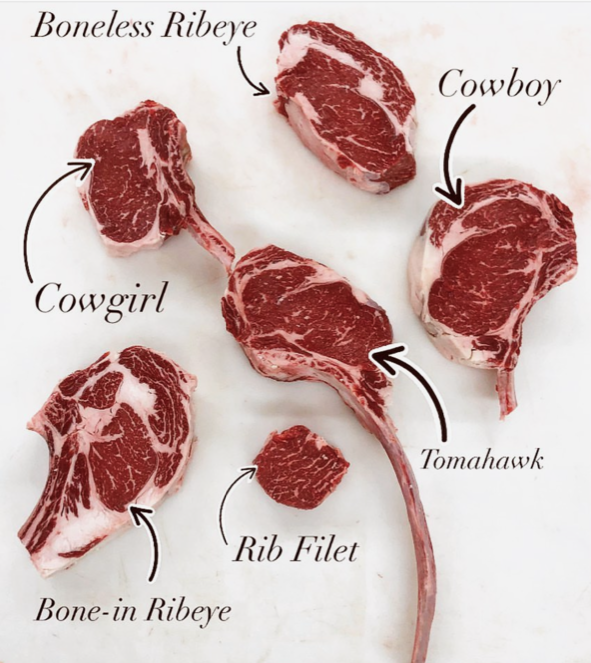
Tomahawk and Ribeye steaks are two popular cuts of beef that are often compared. Both steaks are cut from the prime rib and are known for their marbling and juicy texture. Although they differ in some ways, they also have significant similarities.
Both steaks are typically more expensive than a boneless ribeye due to the added flavor and depth that the bone brings to the meat. Additionally, Tomahawk and Ribeye steaks can be prepared using various cooking methods, such as grilling and searing, and are best cooked to medium-rare or medium for optimal tenderness.
Finally, both steaks are beloved by meat enthusiasts worldwide for their rich flavor and luxurious texture, making them a must-try for any serious steak lover.
What Are The Key Differences Between Tomahawk Vs Ribeye?
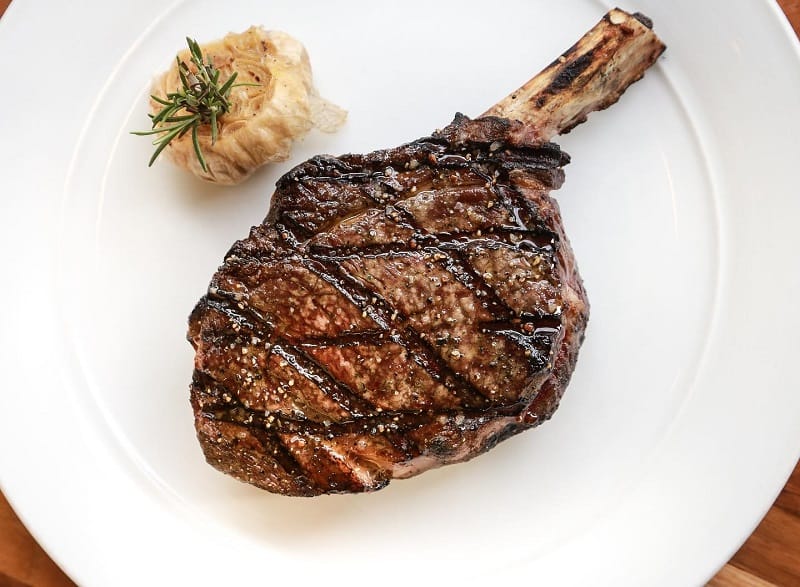
Tomahawk and ribeye steaks are two popular cuts of beef with distinct differences. The tomahawk steak is a bone-in ribeye steak taken from the sixth to twelfth rib. It has a distinctive appearance as at least 5 inches of bone protruding from the meat, giving it a hatchet-like shape. The ribeye steak, also known as a Scotch fillet, is taken from the rib section or primal rib and can be bone-in or boneless.
While both steaks have a rich beefy flavor, the tomahawk steak has a buttery texture and is incredibly tender, thanks to the muscles from which it is taken, being rarely used by the cow. In contrast, the ribeye can be slightly tougher but with a variety of textures depending on where it is taken from the rib section.
Additionally, tomahawk and OP rib steaks require reverse grilling to cook them properly, while the boneless ribeye can be cooked more easily on a grill or pan. Both cuts offer unique flavors and are great options for beef lovers.
Texture
While both cuts are known for their flavorful and juicy texture, the Tomahawk steak has a more tender, buttery texture, while the Ribeye is slightly tougher with a more robust beef flavor. This difference in texture can be attributed to each steak’s marbling content, thickness, and style. The Tomahawk steak typically marbles more than the Ribeye, contributing to its tenderness.
Additionally, the Tomahawk steak is a thicker cut of meat than the Ribeye, allowing heat to transfer evenly to help break down the muscle fibers and create a more tender texture. Furthermore, the bone-in style of the Tomahawk steak also contributes to its tenderness and rich flavor. These factors make the Tomahawk steak a more premium and sought-after cut of beef compared to the more affordable and easier-to-cook Ribeye.
Taste
Despite originating from the same section of a cow, these steaks have distinct differences in their taste. The key difference lies in their marbling content. Tomahawk steaks generally have more marbling than ribeye, which makes them more flavorful and tender. The fat in marbling melts when cooked, coats the muscle, and breaks down the fibers in the muscle, making the steak more tender. A tomahawk steak’s thickness and bone-in style make it more tender than a ribeye.
While both steaks offer a classic beef taste, some people believe that tomahawk steaks have a slightly more intense flavor due to the added bone. However, this is subjective and may vary from person to person.
Read more:
- Ribeye Vs Striploin
- Chuck Eye Vs Ribeye
- New York Strip Vs Ribeye
- Prime Rib Vs Ribeye
- Filet Mignon Vs Ribeye
Fat Content
In terms of fat content, Tomahawk steak generally has a higher fat content than ribeye. This is because of the extra marbling that the tomahawk has. Marbling is the visible pattern of fat throughout the meat. More marbling means more fat, which results in a juicier and more tender steak. On the other hand, ribeye steak has slightly less fat content, making it less juicy. However, it has a more robust beef flavor.
Calories
While both are cuts of beef, the tomahawk tends to have a higher fat content, which can contribute to more calories overall. A 6-ounce portion of tomahawk steak can contain up to 650 calories, while a similarly sized ribeye steak may have closer to 450 calories.
However, it is essential to note that calorie counts can vary depending on factors such as cooking methods and seasoning. Additionally, both types of steak can be part of a balanced and healthy diet when consumed in moderation and paired with nutrient-rich sides and vegetables.
Marbling
The Tomahawk steak boasts quite a bit of marbling due to the muscle it is taken from being rarely used by the cow. This area is also quite a bit fattier, which adds to the intense flavor that Tomahawk steaks are known for, commonly described as having a rich, buttery flavor. On the other hand, the Ribeye steak also has marbling, but it tends to have a slightly less intense flavor than the Tomahawk. However, the Ribeye is still highly regarded for its robust beef flavor.
Bone-in Ribeye vs. Tomahawk
The main difference between these two cuts is the presence or absence of bones. The Tomahawk steak features a long bone, while the ribeye steak is boneless. Additionally, both cuts are taken from different parts of the cow. The ribeye steak is cut from the large muscle group running along the cow’s back, while the tomahawk steak is a bone-in ribeye steak taken from the rib area.
Due to the presence of a bone, the Tomahawk and OP Rib steaks require reverse grill searing and take longer to cook than a boneless ribeye. While both cuts have the same flavor profile, bone-in steaks make for a unique presentation, and boneless ribeye steaks allow for caramelizing on all sides evenly.
Are Tomahawk Steaks More Expensive Than Ribeyes?
Tomahawk steaks are typically more expensive than ribeye steaks due to several factors.
- Firstly, tomahawk steaks are cut from high-quality primal cuts, like bone-in ribeyes, known for tenderness and flavor due to marbled fat within the meat.
- Secondly, tomahawk steaks require extra processing and preparation, as the meat is scraped off about 5 inches of the rib bone to create a “handle” for the steak. Additionally, tomahawk steaks are usually larger and heavier, weighing about 3 to 4 pounds with at least a foot-long bone, compared to 8 ounces to 2 pounds of ribeye steaks.
- Lastly, tomahawk steaks are well-marketed and considered a novelty item, making them pricier than other expensive steak options.
Cooking Method
While the preferred cooking methods are similar, there are variations in ideal cooking time and temperature due to differences in size, thickness, and bone in a tomahawk steak. These must be considered when preparing these flavorful cuts of beef. Tomahawk steak is a thicker cut of meat than ribeye, which allows heat to transfer evenly to help ensure it is cooked through without becoming too tough.
The recommended cooking time for a medium-done ribeye steak is around 3-4 minutes on each side at 450 degrees Fahrenheit, while a tomahawk steak requires around 10-12 minutes on each side at the same temperature. For grill and broil cooking, a tomahawk steak should be cooked for 8-9 minutes on each side at a high temperature of 500 degrees Fahrenheit, while ribeye requires only 4-5 minutes on each side at the same temperature.
Ingredients
A tomahawk steak is a bone-in ribeye steak taken from the sixth and twelfth ribs. It always has the rib bone intact and is butchered so that at least 5 inches of bone is protruding from the meat. On the other hand, ribeye steak, also known as Scotch fillet, can either be boneless or bone-in and is taken from the rib section or primal rib, one of the nine primal cuts of beef.
Which Cut Of Steak Is More Popular In High-End Restaurants: Tomahawk Or Ribeye?
Regarding high-end restaurants, the popularity of steak cuts is often based on their quality and taste. Tomahawk or Ribeyy, the popularity of each cut will depend on individual preferences and dining experiences. However, based on factual data, both tomahawk steak and ribeye continue to be well-loved choices in high-end steak establishments.
Which Cut Is More Tender, Ribeye vs Tomahawk?
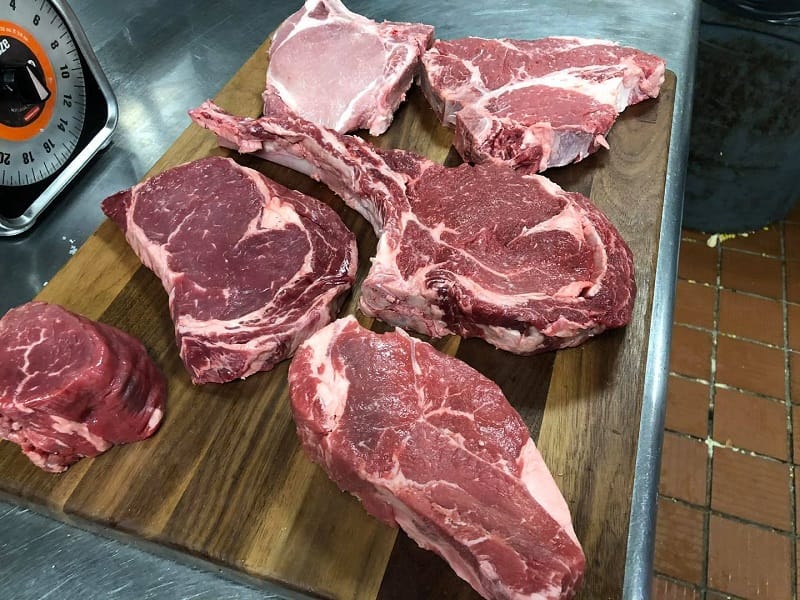
When comparing the tenderness of ribeye and tomahawk steak, it is important to consider their origin and structure. Although the two steaks share similarities, there are differences in their texture and flavor. The tomahawk steak boasts a buttery texture and rich, intense flavor due to the little-used muscle area’s high marbling and fat content. On the other hand, the ribeye steak has a robust beef flavor but is slightly tougher than the tomahawk. Despite the tomahawk’s popularity and expensive price, ribeye steak remains a classic and less expensive option that is also easier to cook.
Which Cut Is More Flavorful, Tomahawk Or Ribeye?
The Tomahawk steak is known for its juicy texture, robust meat flavor, and signature melt-in-your-mouth taste. However, it is challenging to cook and may cost a pretty penny. On the other hand, the Ribeye steak is one of the most popular and decadent cuts available. It is incredibly juicy and full of flavor. While both cuts start the same size, the Cowboy steak tends to be smaller once the fat and bone are trimmed away, whereas the Tomahawk steak is known for its extra bone and slightly chewy texture.
Are There Any Health Benefits Or Drawbacks To Eating A Tomahawk?
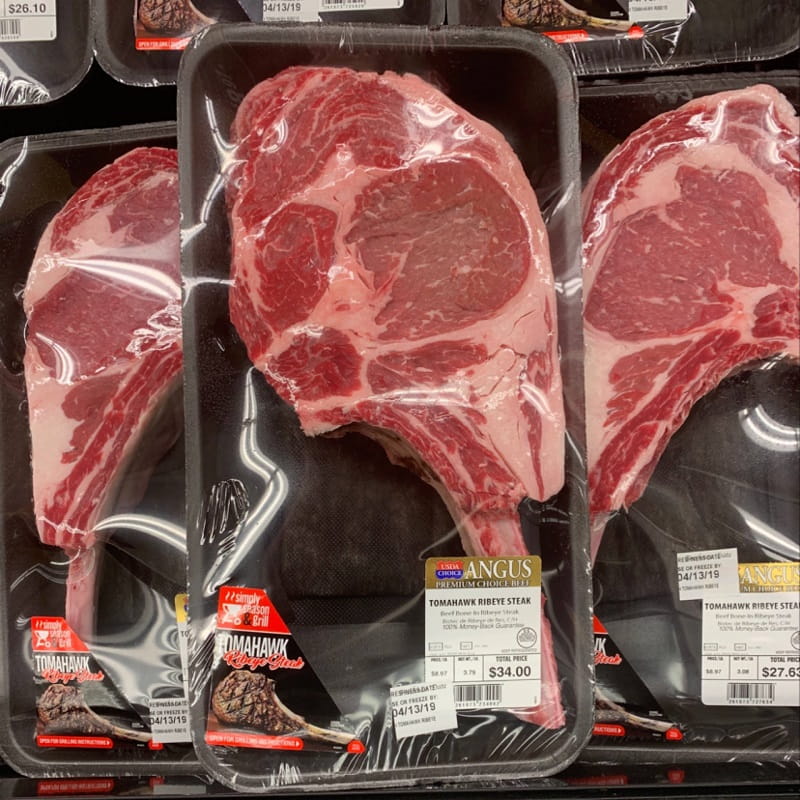
The Tomahawk steak’s impressive cut of meat is visually stunning and has a reputation for being a delicious and indulgent treat. However, as with any food, I couldn’t help but wonder if eating a Tomahawk had any health benefits or drawbacks, and here’s what I found:
Health Benefits of Eating a Tomahawk:
- Nutrient-rich: A tomahawk steak is packed with essential vitamins and minerals that are beneficial for the body. It contains high amounts of iron, zinc, vitamin B12, and vitamin D, which promote healthy bones, boost the immune system, and improve mental health.
- High-protein content: Tomahawk steak is a great source of protein, which is essential for building and repairing muscle tissues. Protein also helps to increase energy levels and reduce cravings.
- Omega-3 fatty acids: Tomahawk steak is packed with Omega-3 fatty acids, which are essential for maintaining heart health, reducing inflammation, and improving brain function.
Drawbacks of Eating a Tomahawk:
- High-calorie count: Tomahawk steak is a high-calorie food and should be consumed in moderation. Overconsumption of the steak can lead to weight gain and obesity.
- High-saturated fat content: Tomahawk steak is high in saturated fat, which can raise cholesterol levels and increase the risk of heart disease if consumed in excess.
- Preparation: Preparing a tomahawk steak requires a certain level of skill and attention. The steak can be difficult to cook and may not be suitable for beginners.
While tomahawk steak offers numerous health benefits, it should be consumed in moderation due to its high-calorie and saturated fat content. When prepared properly and consumed as part of a well-balanced diet, tomahawk steak can be a delicious and nutritious addition to one’s diet.
Are There Any Health Benefits Or Drawbacks To Eating A Ribeye?
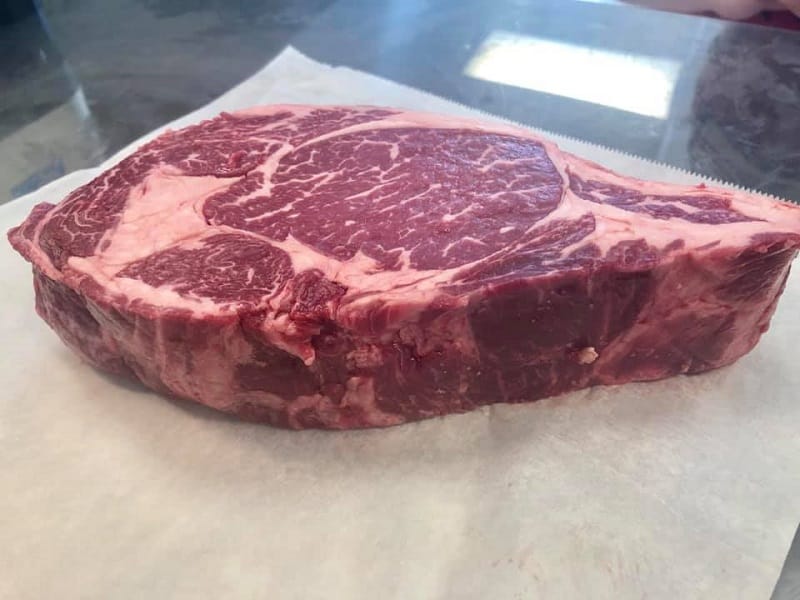
Let’s explore the health benefits and drawbacks of eating ribeye:
Health Benefits:
- Abundance of Nutrients: Ribeye steak is packed with various nutrients, including B vitamins, zinc, selenium, vitamin D, iron, creatine, taurine, and carnosine. These nutrients are vital for maintaining healthy bodily functions and support brain, muscle, and immune health.
- Protein Source: Ribeye steak provides all seven essential amino acids for body tissue growth and maintenance.
- Satiating: Ribeye steak is extremely filling due to its high protein and fat content, making it a great option for those trying to lose weight or maintain their weight while still feeling full.
- Heart Health: Contrary to popular belief, the saturated fat content in ribeye steak is not linked to heart disease, cancer, stroke, diabetes, or heart attack, according to recent studies. In fact, a study in the Journal of the American College of Cardiology found that unprocessed meat like ribeye steak is not associated with an increased risk of heart disease.
Drawbacks:
- High Saturated Fat Content: While the saturated fat in ribeye steak is not harmful to most people, it is still high in saturated fat, which should be limited in the diet. It is important to balance the intake of ribeye steak with other protein sources lower in saturated fat, such as poultry, fish, and legumes.
- Cholesterol: Ribeye steak is also high in cholesterol, which can be a concern for those with high cholesterol levels or a family history of heart disease. It is recommended that these individuals limit their intake of high-cholesterol foods like ribeye steak.
- Processing: If the ribeye steak is processed or contains added hormones, antibiotics, or preservatives such as nitrates or nitrites, it may pose health risks such as increased inflammation, antibiotic resistance, and potential exposure to harmful chemicals.
In conclusion, ribeye steak provides many health benefits but should be consumed in moderation due to its high saturated fat and cholesterol content. It is essential to choose high-quality, unprocessed steak and incorporate a variety of protein sources in the diet to maintain a well-balanced and healthy diet.
How Do You Season A Tomahawk Steak?
When seasoning a Tomahawk steak, there are a few important steps to ensure the best flavor and texture.
- Firstly, it’s recommended to dry brine the steak by generously salting it with kosher salt and leaving it uncovered in the refrigerator for 12-24 hours. This helps improve the texture and flavor of the meat.
- After this, a seasoning rub, typically a mixture of olive oil, paprika, black pepper, and crushed garlic, can be applied. It’s important to coat the entire steak and bone area with the rub mixture.
- Once the steak has been seasoned, it can be cooked using the reverse sear. Slow roasting the meat in a low-temperature oven before finishing it with a quick sear on the grill helps to create a delicious crust and lock in flavors.
With these simple steps and techniques, anyone can season and cook a flavorful and juicy Tomahawk steak at home.
How Do You Season A Ribeye?
Seasoning a ribeye steak requires some knowledge of the different spices that work well and the best technique for enhancing the flavor and tenderness of the meat.
Adding salt to the steak is a must, as it creates a brine that helps tenderize and flavor the meat. Other seasonings such as black pepper, garlic, minced onion, thyme, and tarragon can be added according to personal preference.
The best time to season a ribeye is about 40-45 minutes before cooking to allow the salt to permeate the meat and absorb the natural juices, creating a juicy and flavorful steak. Seasoning is key to getting the perfect sear and crust outside the meat, whether cooking on a grill or a stovetop.
Overall, seasoning a ribeye steak is a combination of art and science that requires attention to detail and patience to get the best results.
How Should I Slice And Serve A Tomahawk Steak Or Ribeye?
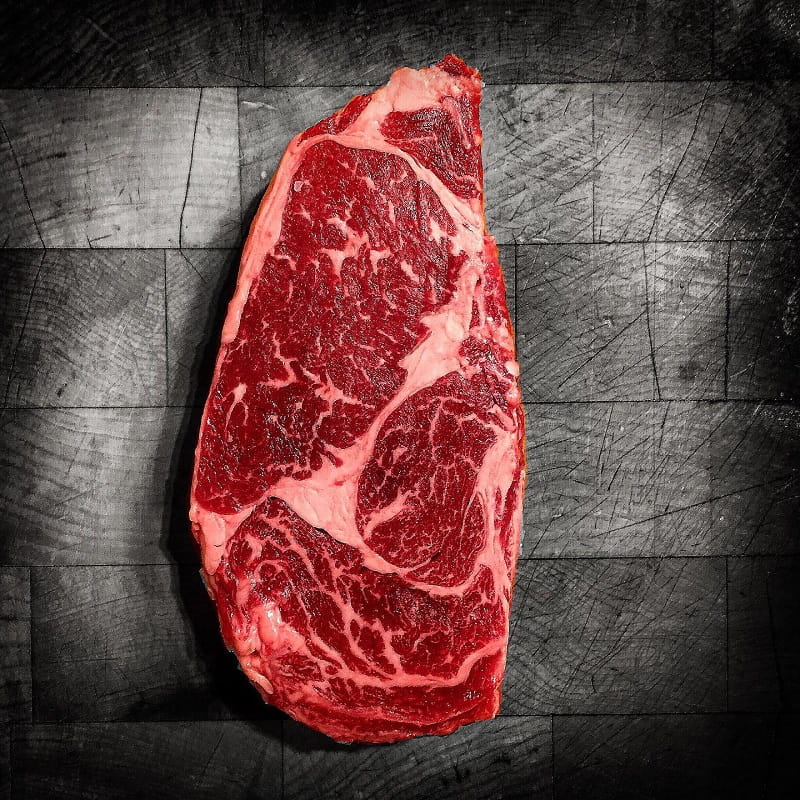
According to experts, the recommended internal temperature to cook a tomahawk or ribeye steak is around 130°F to 135°F for a medium-rare finish. For a medium finish, the temperature should be around 140°F to 145°F, while for a medium-well-done steak, it should be around 150°F to 155°F.
However, it is important to note that the internal temperature may vary depending on factors such as steak thickness, cooking method, and personal preference. To ensure that the steak is cooked to perfection, it is recommended to use a digital instant-read thermometer to monitor the internal temperature.
What Is The Recommended Internal Temperature To Cook A Tomahawk Or Ribeye Steak?
When cooking a Tomahawk or Ribeye steak, it is important to let it rest before slicing and serving. Resting steak is crucial because the heat of cooking pulls the juices in the meat toward the surface. If the steak is sliced immediately after cooking, the flavorful juices will end up on the plate rather than in the steak.
The recommended resting time for a Tomahawk or Ribeye steak is about 5 minutes, uncovered, before slicing and serving. During this time, the temperature of the meat will continue to rise by approximately 5°F, also known as “carryover cooking.” This resting period allows the juices to settle back into the meat, resulting in a moist and flavorful steak.
It is important to note that the length of resting time may vary depending on the specific cut and thickness of the steak. To ensure the best results, use a meat thermometer to measure the steak’s internal temperature, and follow proper cooking and resting instructions based on the specific cut.
How Long Should A Tomahawk Or Ribeye Steak Rest Before Slicing And Serving?
The recommended resting time varies depending on the thickness and size of the steak. A good rule of thumb is to let the steak rest for at least 5-10 minutes and up to 15-20 minutes for larger cuts. The temperature of the meat will also continue to rise slightly during this time, a process known as carryover cooking. This means taking the steak off the heat a few degrees lower than the desired final temperature is essential so it doesn’t overcook while resting.
Covering the steak loosely with foil while it rests is also important to ensure the best possible result. This helps to retain heat and keep the steak warm without causing it to continue cooking and become overdone. Letting the steak rest properly ensures that every bite is tender, juicy, and full of flavor.
How Do You Choose The Best Quality Tomahawk Or Ribeye Steak For Cooking?
When it comes to cooking a delicious steak, the quality of the meat plays a huge role in the final result. I have spent a lot of time learning about the different cuts of meat and how to choose the best quality for cooking. Today, I will share my knowledge on choosing the best quality tomahawk or ribeye steak for cooking.
Firstly, it’s important to understand the difference between tomahawk and ribeye steaks. A tomahawk steak is a ribeye steak still attached to the bone. It gets its name from its resemblance to a tomahawk axe. Ribeye steak, on the other hand, is a cut of meat from the cow’s rib section.
One of the most important factors to consider when choosing a steak is the grade of the meat. The United States Department of Agriculture (USDA) grades beef based on its marbling, color, and texture. The top three grades are Prime, Choice, and Select. Prime-grade beef has the highest level of marbling and is the most tender and flavorful. Choice-grade beef is still good quality but has slightly less marbling than Prime. Select-grade beef has the least marbling and tends to be less flavorful and tender.
Choosing between a tomahawk and ribeye steak comes down to personal preference. Tomahawk steaks tend to be larger and have more bone than ribeye steaks. They also tend to be more expensive due to their size and presentation. Ribeye steaks, on the other hand, are smaller and often more affordable. They are also easier to cook evenly due to their uniform shape.
Once you’ve decided on the type of steak you want, it’s time to choose the specific cut. Look for a steak that has a bright red color with white fat marbling throughout. Avoid steaks that have a grayish color or are discolored in any way. The fat should be evenly distributed throughout the meat, not just on one side.
When purchasing your steak, buying from a reputable butcher or meat market is best. They will have a better selection of high-quality meat and will be able to provide you with helpful advice on how to cook your steak.
In conclusion, choosing the best quality tomahawk or ribeye steak for cooking comes down to understanding the different grades of meat, personal preference, and choosing a steak with bright red color and even fat marbling.
FAQs
Can I Cook A Tomahawk Steak Or Ribeye In A Skillet Or Only On A Grill?
Tomahawk steak and ribeye are delicious cuts of beef that can be cooked in various ways, including on a grill or in a skillet. Regardless of the cooking method, ensuring the steak is completely thawed before cooking and seasoned to taste is crucial.
Grilling tomahawk steak and ribeye on a preheated grill is one of the best ways to cook these cuts, with gas and charcoal grills being great options. Sear the steak on each side for 1-2 minutes, then reduce heat and continue to grill until the meat thermometer reads 130°F, which should take around 20-22 minutes for a 2-inch steak. Allow it to rest for 5 minutes before serving.
If using a skillet, preheat it on medium-high heat with butter before searing the steak for 2-3 minutes on each side until the internal temperature reaches 120-125°F for medium rare. If cooking steak in the oven, season it with salt and pepper and sear it on the skillet for 2-3 minutes on each side before roasting it in the oven at 375°F for 8-10 minutes until it reaches the desired doneness, as determined with a meat thermometer.
Any of these methods is suitable for cooking tomahawk steak and ribeye, so choose the most convenient and enjoy a mouth-watering meal.
How Long Should You Cook A Tomahawk Steak For?
When considering the cooking time, there are a few factors to keep in mind, such as the thickness of the steak and personal preference for the desired doneness. A meat thermometer is recommended to determine the steak’s internal temperature accurately.
For a medium-rare steak, the internal temperature should reach 130 degrees Fahrenheit after cooking, which requires approximately 30-40 minutes in a low-temperature oven and 2-3 minutes for searing on a medium-high grill. Let the steak rest for 5 minutes before slicing to ensure it is juicy and tender. A Tomahawk steak can be a delicious and impressive meal with the proper cooking time and techniques.
What Is The Optimal Temperature To Cook A Tomahawk Steak?
The best way to cook a tomahawk steak is to use the reverse sear method, where the steak is first cooked over indirect lower heat at around 225°F (121°C). This will ensure even heating of the steak’s interior, resulting in a juicy and flavorful finish.
To avoid overcooked meat, it’s recommended to pre-heat the steak on a grill. When the steak reaches a temperature about 10°F (11°C) below the desired doneness, it’s time to sear it over high heat at a temperature of around 450°F (232°C) until the crust looks perfect and the internal temperature is about 3°F (1.7°C) below the desired finish temperature.
It’s important to use a thermometer to monitor the steak’s internal temperature throughout the cooking process, especially since a tomahawk steak has a larger thermal mass, which means carryover cooking will be a bigger concern.
How Rare Or Well-Done Should The Steak Be Cooked?
When it comes to steak, the level of doneness affects flavor and juiciness. Rare steak is cooked for a short time, leaving a red center. It is safe to eat since steak does not contain the parasites that chicken and pork do.
Medium rare steak has a warm, pink to-red center and a pronounced pink band in the middle. This steak is ideal for those who want a slightly juicy steak without blood. A well-done steak is normally charred and has no pink in it. Research suggests that too much well-done meat may increase the risk of colon tumors, colon polyps, type II diabetes, coronary heart disease, and colorectal cancer.
Cooking steak to perfection requires using a thermometer. A rare steak has an internal temperature of 120 to 130 F; medium-rare has a temperature of 130 to 135 F; medium has a temperature of 140 to 150 F; medium-well has a temperature of 155 to 165 F; and well-done has a temperature of 170 F or more. Let the steak come to room temperature before it meets the grill so that it will cook evenly.
Conclusion
So, which is the winner in the battle of Tomahawk vs Ribeye? It depends on what you’re looking for. Go for the tomahawk if you want a steak that will impress your dinner guests with its presentation and bold flavor. But if you’re more interested in a reliably delicious steak that’s easy to cook, the ribeye is the way to go.
In the end, there’s no wrong choice regarding these two cuts of meat. The tomahawk and the ribeye are delicious, and it’s up to you to decide which is the perfect fit for your next dinner party or special occasion. So fire up the grill, grab your favorite cut, and enjoy a delicious steak dinner tonight. Whether it’s a tomahawk or a ribeye, you’re in for a treat.
References:
- https://www.kansascitysteaks.com/all-about-steaks/cook-and-grill-steaks-and-roasts/how-to-cook-tomahawk-steak
- https://www.verywellfit.com/ribeye-steak-nutrition-facts-and-health-benefits-4845432
- https://www.traeger.com/learn/how-to-grill-tomahawk-steak
- https://www.spendwithpennies.com/perfect-ribeye-steaks/

Hey readers! Chip Holland here, and I’m a Manager of this website. My passion for writing about it only matches my passion for BBQ. Follow my blog for mouth-watering recipes, tips, and tricks for the perfect smoke, grill, and BBQ. I’m sure you won’t be disappointed!
